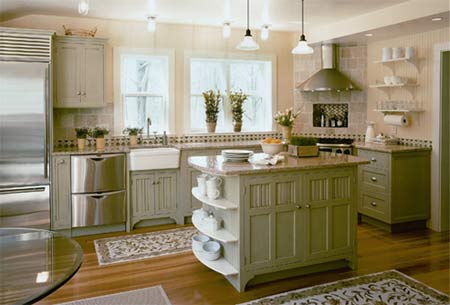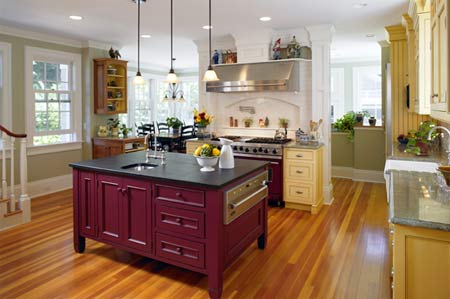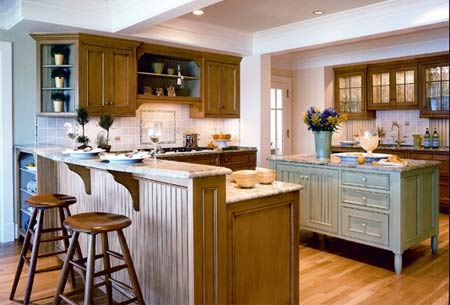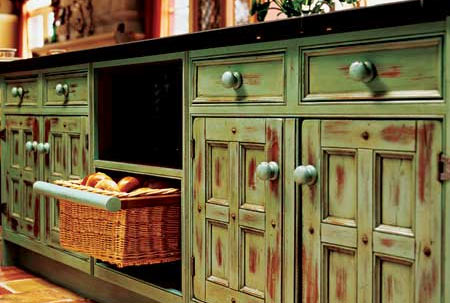A Painted Kitchen
If you want to give a traditional kitchen an update, painting kitchen cabinets is an affordable and fairly easy way of giving your kitchen a face lift. If your kitchen features cabinets stained a dark colour or where the colour has become yellow, a coat of white paint will brighten the look.
PREPARATION
For a professional finish, preparation is essential. Clean the surface area of the wood with a mild soap and water solution. If there is a heavy build up of grease you may need to repeat the process.
I cannot stress the importance of a completely clean surface before you start painting. Rinse thoroughly and allow the wood to dry completely.
PREVIOUSLY VARNISHED, PAINTED OR SEALED
In order to provide a proper surface for the paint, remove hardware and doors (a trick here is to mark each door so that you know which one fits where) and sand all surfaces with 120-grit sandpaper. A sander - such as a Bosch multi sander - is the quickest and easiest way to do this. Finish off by sanding with 240-grit sandpaper to smooth the surface. Always remember that sanding needs to be done with the grain of the wood. Wipe clean once finished.
GOOD TO KNOW
Don't forget to do the thin facing pieces on the carcass and frames. Whilst sanding can be a tedious process, taking the time to sand your cabinets before you prime and paint them will greatly increase longevity of the paint job.
If you really want to add bright colour and a more modern twist on a traditional look take color cues from magazines, flooring, countertops or accent tiles. Since paint is easy to change there’s no reason to be shy when choosing a colour. This is an opportunity to make a bold choice without the risk.
If you’re looking for inspiration try using a classic cream or white scheme for traditional kitchens. Country kitchens work well with vintage colours in hues of red, blue or green, while contemporary kitchens look great with modern greys or sandy taupes.
PRIME BEFORE PAINTING
After sanding it's time to prime the cabinets. Primer forms a better bond with the surface than paint alone, which means that the paint is less likely to chip and peel if it gets bumped. There are several types of primer that you can use, and which one you choose is largely based on what kind of paint you want to use over the top. If you are using an enamel paint, an oil based primer is recommended. Bear in mind that enamel paints take quite a long time to dry and you will need to set everything out so that the doors are not disturbed during the drying time.
Apply the paint with a foam roller for a smoother finish. On cabinets with detail you will need to use a paintbrush. Paint detailed areas first so that you have time to smooth out any imperfections before starting on flat areas. The key to achieving a professional finish with a brush is to use very thin coats. It may be tempting, after all the work you've already to done, to try to coat the paint on as thick as possible just so you can be finished. This is not a good idea. The best and most durable paint jobs are built up by consecutive thin layers of paint, not just one thick one.
Lightly apply your first coat and let it dry completely. If you really want to achieve a professional finish, take some 400 grit sandpaper and very lightly sand the flat surfaces again. You are not trying to remove the paint, but instead are insuring that the next coat has the smoothest possible surface to adhere to.
Once that is complete, add your second coat. In most cases two coats of paint will be sufficient. Occasionally, though, you may find that you get better results from three. This is often true with woods that carry a heavier grain, like oak. Once the doors are painted and fully dry, simply hang them back up, sit back, and enjoy the bright, clean and renewed space that you've worked so hard to achieve.
If you are planning to use a spray paint - such as Rust-Oleum 2X - for your top coat, then a Rust-Oleum primer is essential. This product tends to dry fairly quickly, so make sure that you are ready to go before you begin applying it. Spray painting needs to be done in a well ventilated area. If you have removed the doors from the cabinets, take them outside or into the garage for spraying.
Paint effects and techniques
There are quite a few different paint techniques that you could try in a kitchen and you will find plenty of tips and tricks in our decorating and kitchen sections.
janice anderssen - this old house - diy network





